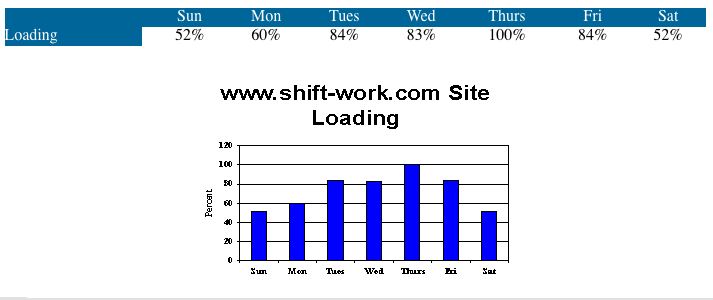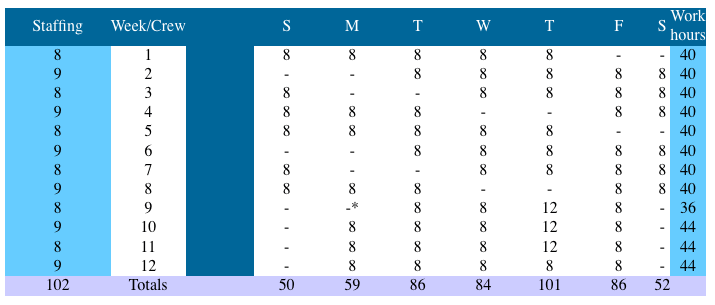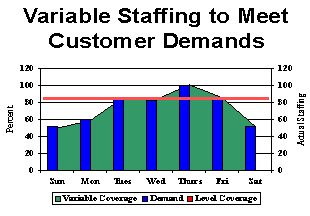So far we have looked at shift schedules that provide level 24/7 coverage. Level coverage means that the same number of personnel with the same capabilities (skills) are on the job at every moment that the shift schedule covers. Many organizations that use level-coverage shift schedules would be more efficient if they had variable coverage.
For example, in a lean manufacturing environment products are produced in response to customer orders (pulling parts through the manufacturing process). Customer demands often vary from day to day, or even from hour to hour. Ideally production capacity should vary with the demands. Unfortunately, a level-coverage schedule does not support this environment well because one of the key components of the manufacturing process, labor resources, does not vary with demand. This usually results in reduced labor efficiency or increased inventory costs (waste in a lean manufacturing environment).
A Concrete Example
Our web site traffic provides a useful example of how customer demands can vary from day to day. Assuming the busiest day (Thursday) is at 100% loading, our historical demand profile is:

For the discussion purposes, let’s assume that we need 100 people, 24 hours/day, to answer internet inquiries on Thursday. We would need 52 people each hour on Sunday, 60 on Monday, etc. While our traffic also varies by the hour of the day, to simplify things we will assume that it is constant all day long.
The shift schedule used to provide this coverage should be selected by developing a number of options that meet the business requirements and our employees’ desires. (See our Change Model). Below, we will discuss one of the potential options that are based on a fixed shift version of archived Shift Schedule #1. Many other options could be created by starting with other basic scheduling concepts.
Shift Schedule Parameters:

Variable Staffing on Shift Schedule #1

8 = 8-hour shift
12 = 12-hour shift
– = Day off
* If 40-hour workweeks are a “must”, you may want to make this day a 4-hour workday that can be used for training, special projects, or other discretionary work.
Schedule Notes
- This shift schedule is a twelve-week cycle staffed by twelve crews on each shift.
- Six crews on each shift are staffed with eight personnel, and six crews are staffed with nine personnel.
- Each crew is assigned to start its schedule in a different week in the cycle. At the end of each week, all crews move down to the next week in the cycle (or return to Week 1).
- The peak workload on Thursday is covered with scheduled overtime by the personnel working the last four weeks of the cycle.
- The staffing is not perfect for every day. However, the actual workload varies from these averages, and absences cause fluctuations in the actual available resources. Unknown variables must still be managed.
Business Issues
This schedule creates a labor resource profile that closely matches our website customer demand on a day to day basis (see below). The question we have to ask — “Is the complication worth it?” A simple cost analysis may help us answer this question.

Just by looking at the graph we can probably conclude that level-coverage schedules will be more expensive in this situation than the variable coverage schedule. The white space below the red line indicates idle time or reduced inefficiencies due to overstaffing. Both the variable-coverage and level-coverage schedules will need to use overtime to meet the Thursday coverage requirements.
To make a cost comparison, we will assume that the cost (including benefits) to provide an hour of coverage on both overtime and straight time is $20/hour. Given this cost, the cost to provide coverage on the variable-coverage shift schedule is:
102 personnel/shift x 3 shifts x 40.67 hours/week x $20/hour = $248,900/week
As an alternative, we could use a level-coverage schedule like archived Shift Schedule #1 to provide coverage. If we used a level-staffing schedule to provide our coverage, like you, we would not staff to 100%. Instead, we would probably staff to about 83% (as shown above) and cover Thursday with overtime. We would also encourage personnel to take vacation time on weekends to get us down to our 52% staffing requirement (this would have a marginal effect since vacation time is limited, and many shift workers prefer to take full weeks off at a time).
Using Shift Schedule #1 to provide 83% coverage would require 83 people on each of four shifts or 332 people. These 332 people would work an average of 42 scheduled hours/week plus an additional 1.2 hours of overtime on Thursdays. Therefore, the weekly cost on this shift schedule is:
83 personnel/shift x 4 shifts x 43.2 hours/week x $20/hour = $286,848/week
Our savings by using the variable-coverage schedule is $37,948/week (over $1.9 million annually.)
Another way to look at this is that the level-coverage schedule is 15.2% more expensive than the variable-coverage schedule.
Employee Issues
Many of the issues discussed when we looked at Shift Schedule #1 apply to this shift schedule. However, the variable staffing schedule does allow for more weekends off and more days off overall. This is good for most shift workers, and brings up an important point:
- Frequently, matching customer demands can result in better matching the shift schedule to the employees’ needs.
As we have said in other schedule topics, these are some of the issues that employers and employees must address when designing a schedule. Other issues and variations on this schedule include:
- Lunches may be paid or unpaid – unpaid lunches may result in idle time at shift change.
- Start times may vary.
- Overtime may be after/before shifts or on days off.
- With smaller organizations, fixed shifts may require special techniques to match the workload.
Finally, one of the most important issues that you must address is the workforce’s needs. No matter how good a schedule looks to the business on paper, if the schedule does not work for the shift workers, it will probably fail in the long run.
Call Us and We Can Help
Call or text us today at (415) 763-5005 to discuss your operations and how we can help you solve your shift work problems. You can also complete our contact form and we will call you.

